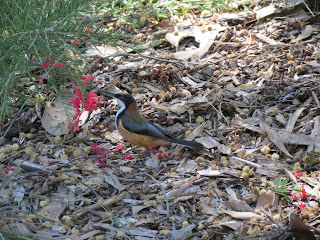The day began extremely well. While having breakfast, we saw a puma walk right in front of the hotel! Apparently this has never happened before, and provided for some great photo opportunities. More than 50 pumas make their homes in Torres Del Paine, feeding off the guanacos and introduced rabbits.
The puma can be found all the way from Patagonia to Canada
I also did a short walk around the hotel, but saw nothing new apart from two
Austral blackbirds.
This photo of an Austral blackbird was taken later on in Santiago.
Soon we had to leave for Grey Lagoon. I chose this walk because the start of it went through Southern Beech forest, and our guide from the previous day, Ana, had reported a chance of seeing Magellanic woodpeckers. The forty-minute drive to the site provided several birds, including
buff-necked ibises, a
chimango caracara and a
Magellanic oystercatcher, though we only stopped for the first two.
Buff-necked ibises are fairly easy to see on the Patagonian grasslands
The chimango caracara is probably Chile's commonest raptor, found even in Santiago
The start of the walk, though beautiful, provided few birds, just
Patagonian sierra finches. When we got to the beach of Grey Lagoon, it was very windy but also amazing to look at.
These icebergs had broken off the Grey Glacier and drifted into the lake
There were several
Austral negritos flying around the beach, as well as a single
dark-faced ground tyrant.
This male Austral negrito dealt very well with the icy cold winds
Later on I saw some of these dark-faced ground tyrants hopping on an iceberg!
As we continued on we walked around a peninsula to get views of the Grey Glacier. There were few new birds on the peninsula, apart from an
Austral parakeet. However, when we reached the end of the walk I saw several birds on the icebergs: two
dark-faced ground tyrants and a
bar-winged cinclodes.
The Austral parakeet is the only parrot that can brave Patagonia's harsh climate
A view of the Grey Glacier from the top of the peninsula
Nobody knows why this bar-winged cinclodes decided to fly onto an iceberg, but it did
As we returned back towards the beech forest, a small mixed flock of thorn-tailed rayaditos, white-throated treerunners and Patagonian sierra finches greeted us, and I could see some upland geese in a nearby river.
This white-throated treerunner is, oddly enough, running up a tree
Upland geese pair for life and males are always seen with a female.
After this we headed back through the forest, looking out for woodpeckers. We saw a large, black bird the size of a woodpecker, but it flew off before we could be certain of its identity.
These marks in the tree were made by feeding woodpeckers
We headed back to the Explora lodge, and soon spotted an Andean condor perched on a cliff in front of the restaurant! While having lunch we watched the condor with the aid of the hotel's telescope.
You can get an idea of the Andean condor's size in this photo
Then we headed off to Sacrimento Lagoon, a place good for guanaco watching and home to a large deposit of stromatolites, rocks formed around dead colonies of ancient bacteria that gave off the oxygen in our atmosphere today. There are stromatolites only in 3 places in the world, including Shark Bay in Australia, and here.
While driving to the lagoon we stopped at a small pond where there were spectacled ducks, a Southern lapwing and two white-tufted grebes. We also stopped to see guanacos.
Spectacled ducks are common throughout Torres Del Paine
The beautiful white-tufted grebe puts Australia's grebes to shame
Southern lapwings have sharp bones on their wings which they use in combat
Many guanacos were present in the area, apparently this area is known as a Puma hunting ground
We walked along a trail towards the stromatolites. There were many Andean condors flying above the trail, and I also saw two great grebes in one of the area's lagoons. The reason for the condors being so prevalent was shown when we stumbled across several guanaco corpses, from previous puma killings.
The great grebe is rather common on Patagonia's larger lakes
Note the white collar on this Andean condor, used to keep its head and neck warm at high altitude
There were many strombolites around the lagoon, and the walking trail went through a large cluster of them. As we continued walking we saw few other birds, apart from some more Austral negritos. The end of the walk was near a lagoon, here I saw two red-gartered coots, and a cinerous harrier flew past before I could take any photos of it.
It was amazing to see these strombolites, once creatures that started life on Earth
Two of these red-gartered coots were swimming around in the lagoon
Then we headed back, planned for the next day and had dinner.




















































